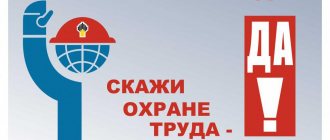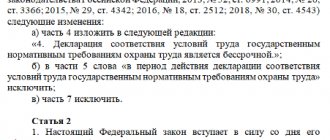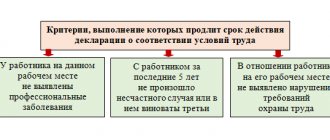Why are briefings needed?
Each company, in order to organize safe work, develops and approves an occupational safety standard.
It contains information about the procedure, frequency of instructions, as well as full name. and positions of responsible persons. In addition, occupational safety instructions are developed and approved for all professions and positions in the organization. These documents are basic for instructing employees. Before being allowed to work, employees must undergo:
- introductory briefing and initial on-the-job training;
- internship (from 2 to 14 shifts).
Employees can begin work after instruction, internship, testing of occupational safety knowledge and if they have proven skills in safe ways to perform work.
Guide: instructions and labor protection
From January 1, 2021, some acts and certain provisions of some acts of the Government of the Russian Federation are declared invalid, and acts and certain provisions of acts of federal executive authorities containing requirements, compliance with which is assessed during the implementation of federal state supervision over compliance with labor legislation and other regulatory legal acts, are repealed , containing labor law standards, and federal state control (supervision) in the field of social services. See Decree of the Government of the Russian Federation dated August 4, 2020 N 1181. Changes will be taken into account in the material when it is updated.
Continue reading in ConsultantPlus
The employee’s immediate supervisor is responsible for conducting on-the-job training. The number of classes depends on the complexity and danger of production or other non-productive activities in which the organization is engaged. An employee who has successfully completed the training can begin work.
Based on the nature and timing of the briefings conducted at the workplace, they are divided into:
- introductory;
- primary;
- repeated;
- target;
- unscheduled.
Let's talk about each of them in more detail.
What is induction training on labor protection
Introductory training on labor protection is a mandatory procedure provided for by law, which all persons hired must undergo.
And there is no difference - a person will work as a cleaner or as the general director of a large company, the future employee has a higher education or three classes at a parochial school.
Because the main task of the employer in terms of labor protection is to provide safe conditions for employees at the enterprise.
Watch the video in which I tell you why it is so important to actually conduct induction training, and I will also leave a link to my channel on Youtube, where you can find other useful information.
Who conducts introductory training on labor protection?
As we found out, according to the law, any organization must conduct induction training!
Now let's look at who should conduct introductory training on labor protection, especially since according to Yandex statistics, people search for this question more than four hundred times a month.
This responsibility is, of course, carried out by a labor protection specialist. And if there is none, then the employee to whom the employer assigned this responsibility by order.
In micro-enterprises, the employer himself can conduct induction training for employed workers, but in this case it is necessary to undergo training in labor safety at a training center.
In my practice, more than once there was a situation when new divisions were opened in our vast homeland, located in Tatarstan, the Komi Republic and other constituent entities of the Russian Federation, and I, as a labor protection specialist, am at an enterprise in the Krasnodar Territory, and the CHS for these facilities has not yet accepted, but induction training needs to be carried out!
And I didn’t always have the opportunity to go on a business trip, and what should I do - break the law and not properly care about the lives and health of people? After all, you cannot start work without conducting introductory instructions:
- Firstly, because something can happen to a person, and after instruction, the risks are significantly reduced.
- Secondly, you can receive a fine from the customer (if you have one). For example, an enterprise, working under contractual obligations with Rosneft, can receive an order and a fine of at least 200-300 rubles, and audits and inspections at sites are carried out at least once a quarter, or even more often.
- Thirdly, if something happens to a person, then a fine from the state cannot be avoided.
You can verify this by reading Part 1 of Article 5.27.1 of the Code of Administrative Offences, where the following amounts of administrative liability appear:
- for officials in the amount of two thousand to five thousand rubles;
- for persons carrying out entrepreneurial activities without forming a legal entity - from two thousand to five thousand rubles;
- for legal entities - from fifty thousand to eighty thousand rubles.
Therefore, in my situation, in order not to run into trouble, I chose a responsible engineering and technical worker (engineering and technical worker) trained at the training center and, by order of appointing the person responsible for conducting the induction training, delegated this responsibility to him.
And if it is not possible to appoint someone responsible for conducting the introductory briefing, then you have to look for other solutions, but nevertheless record the introductory briefing. Watch the video in which I tell you in detail how to arrange and conduct instructions for remote workers.
How safety induction training will help workers
Introductory safety briefing is a good thing, in fact important, and it’s not for nothing that they are required to carry it out, because, think for yourself, during the briefing, the employee being hired must learn everything about the specifics of the enterprise, what rules and procedures apply there, and not Just for show, just to sign.
Therefore, during the briefing it is necessary to talk about the following:
- about working hours, regulated breaks, internal labor regulations;
- basic rules of behavior and safety;
- about the structure of the enterprise;
- what equipment is used, the dangers it may pose;
- whether transport and special equipment move around the territory;
- how to behave in case of fire;
- what to do if you feel unwell or find a colleague who needs first aid, and so on.
I have a security guard I know who told me how his “automatic” actions saved the life of a man passing by his guarded facility when he had an epileptic attack.
He simply speaks on a whim, remembering what he was taught - he “opened his mouth” with teaspoons and pulled out his tongue when the person was almost suffocated.
Therefore, it is possible that your introductory safety briefing will save someone’s life or save them from injury, so I advise you to approach this process not only as a matter of form.
Induction training log
Bureaucracy, apparently, was not invented by humanity in vain, because if you do not document many points, then how can you prove to people (organizations, government agencies, etc.) that you are right?
If a situation arises, then words will no longer help the matter, so everything must be documented!
What do you think is the easiest way to record completion of the introductory training on labor protection?
Watch the video in which I talk in detail about documenting the introductory briefing, from it you will learn step by step how to correctly complete this procedure.
At the end of the conversation, ask a few questions and check how the future employee has learned the information and make an entry in the introductory briefing log, filling it out is not a problem 
The journal must be numbered, stitched and sealed with the seal of the institution. If you are the person responsible for maintaining it, then put your signature.
When keeping a journal, it is not allowed to make gaps in the lines; fill in each one.
When I first came across everything, I had a question - what is the shelf life of the introductory briefing log?
I found the answer here - based on clause 626 of section 7.3 of the list to the order of the Ministry of Culture of Russia dated August 25, 2010 No. 558, the induction training log at the enterprise is kept for 10 years!
But from experience I can already say that you need to remember that information about completing the induction training is necessary when investigating an accident at work, so I recommend that the logs not be recycled or destroyed, but stored for 45 years from the date of completion.
It's good if you don't need it, but it's better to be safe!
And by the way, the form of the log of introductory briefing on labor protection and all the forms of documents specified in GOST are advisory in nature, although throughout Russia they are used in just such variants.
You can read more in detail in GOST 12.0.004-2015 “Organization of occupational safety training.”
The employer has the right to approve any of its forms, the main thing is that there are signatures of the instructor and the instructee and a record of when the induction training was conducted.
Therefore, working in a large enterprise, where the offices of labor protection, fire safety, civil defense and emergency situations and energy are located at a sufficient distance from each other, I developed a personal card for undergoing induction training, so that the future employee would not forget to visit anyone and everyone would be briefed.
Who needs to undergo induction training? Nuances!
As you already understood, before starting work, all employees undergo induction training.
Ideally, a future employee should first visit the labor protection department, and then go and register.
But this rarely happens. More often it’s the other way around! ends
I will provide a list of persons subject to induction training in accordance with the regulations of clause 2.1.2 of Resolution No. 1/29:
- all newly admitted;
- travel allowances to your company (branch) from other facilities;
- trainees;
- other persons involved in the production processes of the enterprise.
Not long ago I came across such a situation - employees’ fixed-term contracts ended and, upon completion, they were accepted back into the company.
At the same time, I drew the attention of the head of this structural unit about the need to undergo induction training and, accordingly, at the workplace, with all that it implies.
His indignation knew no bounds; naturally, I was told that I was a bureaucrat, throwing out unnecessary paperwork and inventing unnecessary work. Well, this is not true at all!
I just don’t consider repeated induction training for an employee an unnecessary process, and I also work according to the letter of the law, namely, in paragraph 2.1.1 of Resolution No. 1/29.
Which states that all persons hired, as well as employees transferred to another job, are required by the employer (or a person authorized by him) to undergo labor safety training. Everything must be clear.
The date of conclusion of the employment contract must coincide with the date of the induction training.
Initial briefing
It is carried out by the immediate supervisor, who has been trained and tested for knowledge of occupational safety requirements, as a rule, on the first working day when the employee is allowed to work independently. Required:
- to everyone entering work in the department, including employees who have entered into a contract for a period of up to 2 months. or for the period of seasonal work, as well as part-time workers;
- employees of the organization transferred from another structural unit, or employees who are entrusted with performing work that is new to them;
- seconded employees of other companies, students arriving for practical training, and other persons taking part in the production activities of the enterprise.
But for some categories of employees an exception may be made. Persons whose work is not related to the operation, maintenance, testing, adjustment and repair of equipment, the use of electrified or other tools, or the storage and use of raw materials and materials may not undergo instruction. The list of positions of employees exempt from employment is approved by the employer.
The following issues are covered during the training:
- route to the workplace;
- methods of performing job duties;
- precautionary measures;
- requirements for clothing, shoes and general appearance of the employee.
Read more: Initial briefing on labor protection in the workplace
Re-briefing
It is carried out by the immediate superior in the following cases:
- if an emergency situation arises, during which it turns out that employees lack knowledge in the field of occupational safety and workplace safety;
- after some time to update employees' knowledge.
As a rule, all workers undergo repeated training at the workplace, the frequency of which should be at least once every 6 months. It does not matter their qualifications, education, experience, or the nature of the work performed.
Workers whose work is associated with high-risk equipment must also be given repeated instructions on labor protection, the frequency of which is once every 3 months.
At the end of the training, the instructor conducts an oral debriefing to ensure that the employees have mastered the new knowledge.
Induction log
After the employee is familiar with all occupational safety requirements, the inspector conducts an oral examination of the acquired knowledge and skills. After successfully answering the questions, the introductory safety briefing is considered complete, which should be recorded in a special logbook. Such a record contains the date of the event, the details of the person being instructed and the person instructing, and the division of the company where the employee is employed is indicated. Records must be certified with the signatures of the person being instructed and the person instructing (clause 2.1.3 of the Training Procedure). Another record that the employee has been properly instructed about safe working conditions must be included in his personal card (if the organization has one).
It should be noted that the forms of the registration log and personal card for completing occupational safety training are given in Appendix A to GOST 12.0.004-2015 (forms A.4 and A.2). They are not mandatory, but recommended, so each company approves convenient forms for itself. The log sheet for the introductory briefing on labor protection, compiled according to the recommended form, looks like this:
Unscheduled briefing
It can be carried out:
- separately with each employee;
- with a group of employees with the same profession.
The volume and content of training depends on the reasons and circumstances that necessitated its implementation. It is carried out by the immediate supervisor when:
- the introduction of new and amended legislative acts relating to occupational safety, as well as instructions on occupational safety;
- changing technological processes, installing new equipment, etc.;
- violation by employees of occupational safety requirements, if this may cause an accident at work or accident;
- at the insistence of officials of state supervision and control bodies;
- during long breaks in work (for work with harmful and/or dangerous conditions - more than 30 calendar days, and for other work - more than two months);
- by the employer's decision.
The results obtained during instruction are recorded by the instructor in a special journal. The employee gets acquainted with them under his personal signature. The instructor also signs in the appropriate box.
Induction program for employees of the organization
Name of company
I CONFIRM:
Head of the organization __________ Full name
PROGRAM
induction training for employees
| No. | Topic name | Number of hours |
| 1. | General information about the enterprise, characteristic features of production | 0,25 |
| 2. | Basic provisions of labor law | 0,75 |
| 2.1 | Employment contract, working hours and rest time. Benefits and compensation. | 0,25 |
| 2.2 | Internal labor regulations. Responsibility for violating the rules. | 0,25 |
| 2.3 | Organization of labor protection work at the enterprise. Departmental, state and public control over the state of labor protection. | 0,25 |
| 3. | General rules of conduct for workers on the territory of the enterprise. Location of main and auxiliary premises. Location of main workshops and office premises. | 0,25 |
| 4. | The main dangerous and harmful production factors characteristic of production. | 0,5 |
| 5. | Methods and means of preventing accidents and diseases: collective protective equipment, posters, safety signs. | 0,5 |
| 6. | Basic requirements for the prevention of electrical injuries. | 0,5 |
| 7. | Basic requirements for industrial sanitation and personal hygiene. | 0,25 |
| 8. | Individual protection means. Procedure and standards for issuing PPE. | 0,5 |
| 9. | Circumstances and causes of accidents that occurred at the enterprise and other similar industries. | 0,5 |
| 10. | Procedure for investigating industrial accidents and occupational diseases | 0,5 |
| 11. | Fire safety. Ways and means of preventing fires. Actions of personnel when they occur. | 0,5 |
| 12. | First aid for victims. Actions of workers in the event of an accident or emergency. | 0,5 |
| Total: | 5,5 |
Labor safety engineer signature Full name
Based on the introductory briefing program, instructions for conducting introductory briefing are developed. It contains in expanded form the questions included in the program. The number of questions for conducting introductory training, which will reflect the specifics of the organization’s activities, depends on the qualifications and experience of the labor protection specialist.
The prepared program, instructions for conducting induction training and a list of checklists must be approved by the supervisor.
Other security instructions can be downloaded from the Practical Materials section.
If the information was useful, leave a comment and share the link to this article on your social networks. Thank you!










